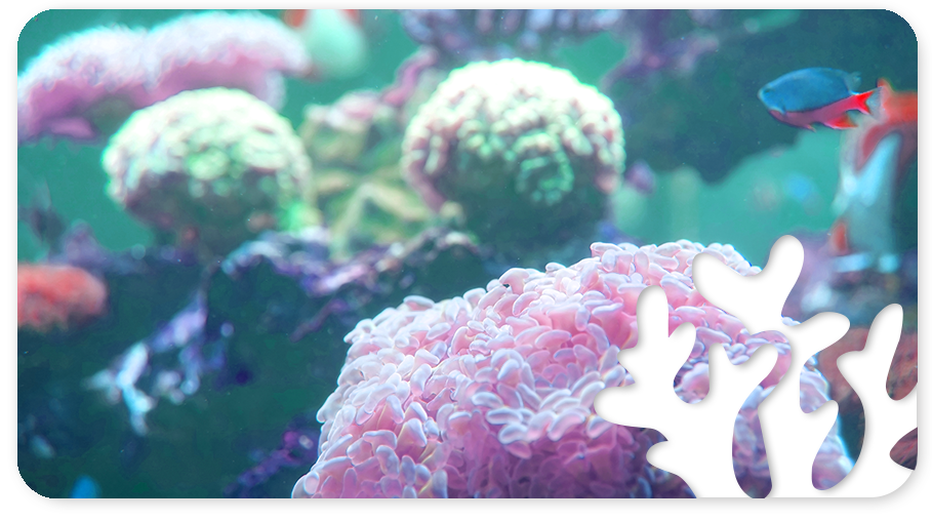|
We’ve all seen breathtaking images of coral reefs, bursting with vibrant color, surrounded by aquatic life. These stunning, living ecosystems support beautiful and healthy coastlines, and play a critical role in our world. Let’s delve into some facts about coral reefs and discover why they are so vital to protect. What Coral Reef Is Did you know that coral is a living animal? Coral reefs are made up of thousands of tiny corals. These coral colonies are called polyps. Is coral a plant? Sometimes people think that coral reefs are made up of plants. They certainly do look like beautiful plants in a way, but they are actually marine invertebrate animals. They have plant-like cells living inside. Just like a jellyfish or a sea anemone, coral is also classified as Cnidarians. Coral has a hard calcium carbonate exoskeleton that is fixed into one place. Each coral polyp has a mouth and a stomach. They continuously divide and grow, creating a blanket like reef along our coasts. Coral reefs grow for thousands and thousands of years, and they can become extremely large! Some Cool Facts About Coral Reefs Coral colonies, if kept healthy, can live for hundreds of thousands of years - and possibly eternally. There are many reasons to study and save these fascinating coral reefs. Facts About Coral Reefs: 1. They Sometimes Glow: Corals can appear in many vibrant, glowing colors. This is because they naturally produce fluorescent pigments. Researchers think that these pigments create a vibrant shield against the dangers of UV light. 2. Hundreds of Species: There are literally hundreds (and possibly more) species of coral. They are a highly diverse animal, coming in a variety of colors, tones, shapes, and different sizes. Some kinds of coral look like tree branches - literally branching out into amazing shapes. While others are soft and wave back and forth in the water, like a fan. Another kind of coral looks like a brain, and is called a brain coral. And pillar corals grow high and tall, making a unique formation, much like a NYC skyline. 3. They Swim And Move: Another fun fact about coral reefs: young coral can actually swim when first produced, while older coral is attached to the ocean floor. The young coral move to other locations and can land to create a new colony. 4. They Eat: Every coral polyp is capable of eating. They have what is called stinging cells in their tentacles. They use these to catch and eat tiny plankton (small plants and animals), much like a jellyfish does. Also, algae lives within the coral cells, and that is another source of food for the coral. Coral Reefs Protect Us And Our Oceans The coral reef’s impact factor is enormous. Coral reefs provide much needed homes for underwater animals to live. Think of coral reefs as a giant landlord or guardian of the sea - like trees are to forests - homing countless coral reef wildlife. All of their tiny nooks provide a safe space for many creatures of the ocean community. As well as protecting many endangered species. The beautiful coral reefs also serve as a source of food (and massive income) for millions of earth’s people. Without them, we wouldn't have our much-desired ocean beaches. They protect our beaches and shorelines from damaging waves, erosion, and even disastrous flooding. Their protection provides tons of jobs and recreation - estimated at about $10 trillion dollars in protection in a single year! Coral reefs provide much-needed medicine! Research shows that the tiny organisms found on our coral reefs can help to produce treatments for many human diseases, including: cancers, cardiovascular diseases, stomach ulcers, and more. The wealth of coral reef’s health benefits are still being discovered. Much current research on cures for cancer concentrate on marine organisms, most of which are located on coral reefs. Literally billions of people truly rely on our beautiful coral reefs for food, income, and protection. Coral Reefs Should Be Protected
Coral reefs provide so much good to us and our world. We must protect and preserve reefs from reef erosion and damage, as much as possible. What damages coral reef health:
So, how can we protect our stressed coral from the many human threats to coral reefs? There are many coral reef restoration methods available and coral reef rehabilitation centers do so much good. However, there are many small steps that can be taken to protect the beautiful healthy coral reefs and coral reef food webs in our oceans. Here are some small steps that you can take to help out:
SeaTak™ Aims To Help Coral Reefs SeaTak™ is doing their part to help coral reefs by thinking of safe, dynamic solutions for coral and ocean restoration. What is coral and ocean restoration? Coral and ocean restoration is done by programs, organizations, alliances, groups and everyday people who devote time, money, energy and resources with the goal to protect and restore coral and coral reefs. With coral bleaching happening all around the world at an alarming rate, efforts to intervene and rehabilitate dying and damaged coral is greatly needed. Many groups are propagating coral in labs and nurseries, preparing it to be out planted in specific locations to promote regrowth and new growth of coral. All in hopes of a future of our world continuing to house coral reefs as a beautiful and healthy functioning part of our ecosystem. How does SeaTak™ help? SeaTak™ is used safely to repair coral in labs and on reefs in the open ocean. It is a ground-breaking adhesive that is inspired by the chemistry of blue mussels. The solution is easy-to-use, works underwater, is long-lasting, durable and non-toxic when fully cured. SeaTak™ addresses several rates of limitation in coral restoration including but not limited to, time, economics, equipment and personal. Another green fact about SeaTak™ is that it does not burn coral or release dangerous toxins into our ocean water. It also reduces the plastic footprint as to current industry standards while increasing productivity (by orders of magnitude). This revolutionary underwater glue is the perfect choice for even the most challenging underwater projects. Together we can make a difference in our world.
0 Comments
Your comment will be posted after it is approved.
Leave a Reply. |
|



